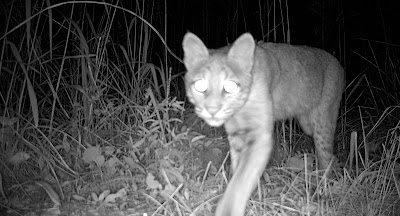Bobcats Photographed in Kankakee Sands Preserve in Will County
The Forest Preserve District of Will County announced October 2, 2020 that motion-activated game cameras photographed bobcats in the Kankakee Sands Preserve in Custer Township.
A Forest Preserve District of Will County game camera photographed bobcats, possibly a mother and her kittens, walking in a small open area at Kankakee Sands Preserve in Custer Township recently. The Forest District’s game cameras have detected bobcats in only three other preserves in recent years. (Photos by Forest Preserve District of Will County)
Full press release:
"Forest Preserve District of Will County game cameras recently captured some rare and exciting photos of bobcats, possibly a mother and her kittens, walking through a small open area in Kankakee Sands Preserve in Custer Township.
The cameras, which are triggered by motion, are used in the preserves to document animal numbers and movements. The information obtained by the cameras helps guide the Forest Preserve District's land management strategies.
Photos of bobcats in the preserves are rare, said Becky Blankenship, the Forest Preserve’s wildlife biologist. So, capturing photos of the creatures was noteworthy because it happens only every couple of years, she said.
“The cameras are set up to take a three-photo burst when they detect motion,” she explained. “Then they have a 10-15 second delay before taking another burst if there is still movement in front of the camera.”
Blankenship said the photos recorded what appears to be a mother and at least two kittens. Females can reach sexual maturity a year after birth, so the mother is at least a year old, and the kittens were likely born this spring, she said.
Bobcats, which are twice the size of a common house cat, have been detected in the Forest Preserve’s Braidwood Dunes and Savanna Nature Preserve, Evans-Judge Preserve, Sugar Creek Preserve and now Kankakee Sands Preserve. Blankenship said bobcats are typically only active at twilight or just before sunrise and they are well camouflaged and avoid people, so that is why they are a rare sight.
“I have only seen a wild bobcat once, and the black-and-white photos do not do them justice,” she said.
According to the Illinois Department of Natural Resources habitat changes and overharvesting of bobcats caused populations to decline severely enough to be listed as threatened in Illinois from 1977-1999. Since then, bobcat populations have responded so well to protection and habitat management that a very restricted hunting and trapping season has been in place since 2016. (Hunting is not allowed in the Forest Preserve District of Will County preserves.) IDNR estimates that there may be up to 5,000 bobcats in Illinois now, and their numbers are still on the rise.
The Forest Preserve District uses game cameras to observe species without needing to be present, Blankenship explained.
“The most common animals caught on camera are deer, squirrels, a variety of birds and raccoons,” she said.
It's important to know what kinds of animals live in a preserve to better manage the environment to help them, she added.
“The history of the bobcat in Illinois shows us the importance of managing habitat for the species that depend on it,” Blankenship said. “Knowing what species occupy our preserves helps guide our habitat management practices.”
For more information on the Forest Preserve District of Will County and its land management practices, visit ReconnectWithNature.org."


